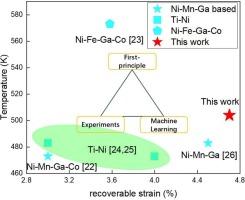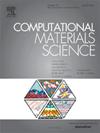高温Ni-Mn-Ga-Cu-B超弹性合金加速设计的数据物理集成策略
IF 3.3
3区 材料科学
Q2 MATERIALS SCIENCE, MULTIDISCIPLINARY
引用次数: 0
摘要
对节能、高温驱动材料的需求日益增长,推动了对先进形状记忆合金的深入研究。特别是基于ni - mn - ga的系统,在超弹性冷却和驱动应用方面有着非凡的前景,但它们面临着一个关键的障碍:在实际驱动应力的高温下,同时提供大的可恢复应变和最小的热滞后。传统的试错合成和测试工作流程非常缓慢,并且需要大量的资源来克服这个瓶颈。在这里,我们报告了一种数据物理集成策略,用于高温超弹性Ni-Mn-Ga-Cu-B形状记忆合金的快速,多目标设计。首先,利用机器学习方法筛选出相变温度为125 ~ 225℃的高温Ni-Mn-Ga基形状记忆合金;SHapley加性解释表明,价电子数和电负性是影响相变温度的主要因素。对8种高温Ni-Mn-Ga-Cu-B形状记忆合金进行了相变温度和超弹性测试。结果表明,Ni50Mn29Ga16Cu2B3复合材料在575 MPa、135℃下的可恢复应变为5.1%,而Ni50Mn29Ga12Cu4B5复合材料在231℃下的可恢复应变为4.7%。基于第一性原理的机制揭示了Cu和B的战略性掺杂稳定了马氏体变体并减少了晶格摩擦。这种统一的策略不仅加速了高性能形状记忆合金的发现,而且为未来材料优化提供了可转移的理论框架,为节能、高温驱动技术铺平了道路。本文章由计算机程序翻译,如有差异,请以英文原文为准。

A data‐physics integrated strategy for accelerated design of high‐temperature Ni–Mn–Ga–Cu–B superelastic alloys
The increasing demand for energy-efficient, high-temperature actuation materials has driven intensive research into advanced shape memory alloys. Ni-Mn-Ga-based systems, in particular, hold exceptional promise for superelastic cooling and actuation applications, but they face a critical hurdle: simultaneously delivering large recoverable strains and minimal thermal hysteresis at elevated temperatures under practical driving stresses. Conventional trial-and-error synthesis and testing workflows are prohibitively slow and resource-intensive to overcome this bottleneck. Here, we report a data-physics integrated strategy for the rapid, multi-objective design of high-temperature superelastic Ni-Mn-Ga-Cu-B shape memory alloys. Firstly, high-temperature Ni-Mn-Ga based shape memory alloys with a phase transformation temperature ranging from 125 to 225 °C were screened out using machine learning methods. SHapley Additive exPlanations has demonstrated that the valence electron number and electronegativity are the primary factors influencing the phase transformation temperature. Further, phase transformation temperature and superelasticity tests were conducted on eight high-temperature Ni-Mn-Ga-Cu-B shape memory alloys. The results indicated that Ni50Mn29Ga16Cu2B3 composition exhibits a recoverable strain of 5.1 % at 135 °C under 575 MPa, while Ni50Mn29Ga12Cu4B5 achieves 4.7 % strain at 231 °C. Mechanistic insights from first-principles reveal that strategic Cu and B doping stabilizes the martensitic variants and reduces lattice friction. This unified strategy not only accelerates the discovery of high-performance shape memory alloys but also provides a transferable theoretical framework for future materials optimization, paving the way toward energy-efficient, high-temperature actuation technologies.
求助全文
通过发布文献求助,成功后即可免费获取论文全文。
去求助
来源期刊

Computational Materials Science
工程技术-材料科学:综合
CiteScore
6.50
自引率
6.10%
发文量
665
审稿时长
26 days
期刊介绍:
The goal of Computational Materials Science is to report on results that provide new or unique insights into, or significantly expand our understanding of, the properties of materials or phenomena associated with their design, synthesis, processing, characterization, and utilization. To be relevant to the journal, the results should be applied or applicable to specific material systems that are discussed within the submission.
 求助内容:
求助内容: 应助结果提醒方式:
应助结果提醒方式:


